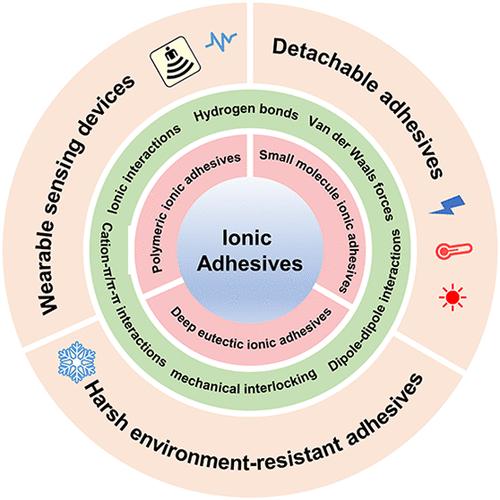离子胶粘剂:设计策略、性能机制和应用
IF 5.2
1区 化学
Q1 POLYMER SCIENCE
引用次数: 0
摘要
离子胶粘剂作为一类智能材料,因其独特的物理化学性质和多功能特性而引起了科学界的广泛关注。这篇综述提供了一个系统的检查设计原则,键合机制和结构-性能关系的离子基粘合剂系统。通过利用动态离子相互作用和定制的聚合物结构,这些材料表现出卓越的性能,包括可调的粘附强度、环境响应性和自我修复能力。其固有的可逆性和对不同基板的适应性使其在柔性电子、生物医学工程和可穿戴设备中得到广泛的应用。综述了离子胶粘剂的研究现状、面临的挑战以及未来的发展前景。最终,这项工作旨在为跨学科应用创造高性能离子粘合剂提供理论指导,从而促进这一快速发展领域的进一步发展。本文章由计算机程序翻译,如有差异,请以英文原文为准。

Ionic Adhesives: Design Strategies, Performance Mechanisms, and Applications
Ionic adhesives, as a class of smart materials, have garnered considerable scientific interest owing to their distinct physicochemical properties and multifunctional characteristics. This review provides a systematic examination of the design principles, bonding mechanisms, and structure–property relationships governing ion-based adhesive systems. By leveraging dynamic ionic interactions and tailored polymer architectures, these materials exhibit exceptional properties, including tunable adhesion strength, environmental responsiveness, and self-healing capabilities. Their inherent reversibility and adaptability to diverse substrates enable a broad spectrum of applications in flexible electronics, biomedical engineering, and wearable devices. This review also summarizes the current research landscape of ionic adhesives, delineating challenges, and future prospects for their continued development. Ultimately, this work aims to provide theoretical guidance for creating high-performance ionic adhesives for interdisciplinary applications, thereby boosting further advancements in this rapidly evolving field.
求助全文
通过发布文献求助,成功后即可免费获取论文全文。
去求助
来源期刊

Macromolecules
工程技术-高分子科学
CiteScore
9.30
自引率
16.40%
发文量
942
审稿时长
2 months
期刊介绍:
Macromolecules publishes original, fundamental, and impactful research on all aspects of polymer science. Topics of interest include synthesis (e.g., controlled polymerizations, polymerization catalysis, post polymerization modification, new monomer structures and polymer architectures, and polymerization mechanisms/kinetics analysis); phase behavior, thermodynamics, dynamic, and ordering/disordering phenomena (e.g., self-assembly, gelation, crystallization, solution/melt/solid-state characteristics); structure and properties (e.g., mechanical and rheological properties, surface/interfacial characteristics, electronic and transport properties); new state of the art characterization (e.g., spectroscopy, scattering, microscopy, rheology), simulation (e.g., Monte Carlo, molecular dynamics, multi-scale/coarse-grained modeling), and theoretical methods. Renewable/sustainable polymers, polymer networks, responsive polymers, electro-, magneto- and opto-active macromolecules, inorganic polymers, charge-transporting polymers (ion-containing, semiconducting, and conducting), nanostructured polymers, and polymer composites are also of interest. Typical papers published in Macromolecules showcase important and innovative concepts, experimental methods/observations, and theoretical/computational approaches that demonstrate a fundamental advance in the understanding of polymers.
 求助内容:
求助内容: 应助结果提醒方式:
应助结果提醒方式:


